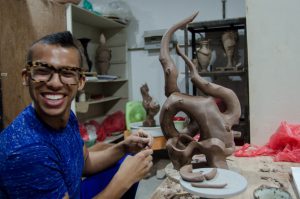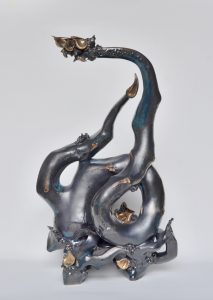
Alex Anderson, 2014-2015, China, working on one of his ceramic sculptures in the studio
During my Fulbright U.S. Student Program grant, I spent 10-months at the China Academy of Art in Hangzhou, where I studied ink painting and was an artist-in-residence in the ceramics department. Considering art as a reflection of the interior world of its maker, it allowed for a clear and genuine lens into the specific interests, psychologies, and motivations of the people in my studio during this period. Prior to my time in China, I had not considered art as a tool for cultural exchange, but the questions that sourced from discussions of each person’s work often moved from the work itself to considerations of its place in contemporary art in China, America, and beyond.
People seemed to view my work and me as equally viable specimens for inspection of what it means to be an American and what American art looks like. There was an interest in the way work was rendered, comments surrounding its content, and discussions of its aesthetic that ultimately led to dialogues about what it means to be an American and the fact that there is no universal definition, as America is an immigrant, hybrid nation. In this respect, art became my primary means of creating mutual understanding and serving as a cultural ambassador. The first question people would ask when they walked through the studio was, “Who made this?” followed by “Where is he from?” These questions opened up spaces for further dialogue around the intersection of Chinese and American art, and sometimes led to discussions of the intersection of China and America.

Dragon Branch
One year after my return to the United States, my Fulbright experience continues to have an impact on my artwork and the way I see the world today. The imagery and techniques I encountered in China significantly enhanced my aesthetic and I often attribute the refinement of my skills to the intense period of development during my time abroad. My Fulbright experience empowered me with a global awareness of the art world that gives me a powerful framework with which to view, make, and understand a broad range of art and the myriad cultural contexts surrounding it. In that respect, I feel one step closer to the freedom that only world experience and deeper knowledge provides and I will continue to use this understanding as a contributor to the art world at large moving forward.
My advice to anyone applying for a Fulbright grant is to make full use of the support systems available to you through your current institution or recent alma mater. If you have a Fulbright Program Adviser, work closely with him or her until you both feel your essays are the best they can be. I also recommend having a professor who is invested in your success review your application materials, as it is likely that he or she is familiar with the grant application process and may have even served on discipline-specific selection committees similar to that of the Fulbright Program. Good luck!
Have questions for Alex about his Fulbright experiences in China and as a Fulbright Alumni Ambassador? You can reach him at AAnderson.alumniambassador@fulbrightmail.org.


No Comments